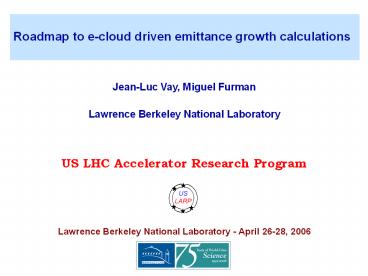Roadmap to ecloud driven emittance growth calculations PowerPoint PPT Presentation
Title: Roadmap to ecloud driven emittance growth calculations
1
Roadmap to e-cloud driven emittance growth
calculations
Jean-Luc Vay, Miguel Furman Lawrence Berkeley
National Laboratory
US LHC Accelerator Research Program
Lawrence Berkeley National Laboratory - April
26-28, 2006
2
E-cloud driven emittance growth concern for LHC
- We propose to use the WARP/POSINST tool to
evaluate e-cloud driven beam instabilities,
emittance growth and (possibly) halo formation, - code suite issued from
- merging of WARP Posinst
new modules
Key operational partially implemented (4/28/06)
Benedetto et al, PRST-AB 8, 124402 (2005)
3
What makes WARP/POSINST unique
- Physics modules
- beam,
- electrons (photosecondary),
- accelerator lattice,
- arbitrary vacuum chamber geometry,
- State-of-the-art
- new electron mover to advance electrons in
magnetic fields with large time steps, - adaptive mesh refinement (speed-up x20,000 LHC 1
bunch/1 FODO cell), - parallel,
- modular, user programmable/steerable.
4
At present, we can run WARP/Posinst in 3 modes
(1)
- Posinst mode (time-dependent)
2-D slab of electrons
s
3-D beam stack of 2-D slab
s0
lattice
A 2-D slab of electrons (macroparticles) sits at
a given station and evolves self-consistently
with its own field kick from beam slabs passing
through external field (dipole, quadrupole, ).
5
At present, we can run WARP/Posinst in 3 modes
(2)
- Slice mode (s-dependent)
2-D beam slab
s
s0 s0?s0
lattice
A 2-D slab of beam (macroparticles) is followed
as it progresses forward from station to station
evolving self-consistently with its own field
external field (dipole, quadrupole, )
prescribed additional species, eventually.
6
At present, we can run WARP/Posinst in 3 modes (3)
- Three-dimensional fully self-consistent
(t-dependent)
Quadrupoles Drifts Bends
WARP/POSINST-3D T 300.5ns
1 LHC FODO cell (107m) - 5 bunches - periodic BC
Beam bunches (macroparticles) and electrons
(macroparticles) evolve self-consistently with
self-field external field (dipole, quadrupole,
).
7
WARP/POSINST benchmarked against High-Current
Experiment (HCX)
Focus of Current Gas/Electron Experiments
INJECTOR
MATCHING SECTION
ELECTROSTATIC QUADRUPOLES
MAGNETIC QUADRUPOLES
1 MeV, 0.18 A, t 5 ?s, 6x1012 K/pulse
Experiment setup for code benchmarking beam
hits end-plate to generate copious electrons
which propagate upstream, leading to observable
currents in diagnostics and effects on the beam.
End plate
8
Wavelength of 5 cm, growing from near center of
4th quad. magnet
0V 0V 0V/9kV
0V
Potential contours
e-
200mA K
MA4
MA3
MA2
MA1
WARP-3D T 4.65?s
Electrons
200mA K
- Good test of secondary module -
no secondary electrons - run time 3 days,
- - without new electron mover and MR, run time
would be 1-2 months!
Beam ions hit end plate
0. -20. -40.
I (mA)
Oscillations
Electrons bunching
(c)
0. -20. -40.
0. 2. time (?s) 6.
6 MHz signal in (C) in simulation AND experiment
I (mA)
(c)
0. 2. time (?s) 6.
9
For emittance growth study, we will add a 4th mode
- Quasi-static mode (s-dependent for e-,
t-dependent for beam) - -- more efficient when electrons can be treated
as steady-flow --
2-D electron Plasma Slab
(Courtesy T. Katsouleas - QuickPIC)
A 2-D Poisson solver is used to calculate
potentials and update positions and velocities in
the electron plasma slab. After the slab is
stepped through the beam, the stored 2-D
potentials are stacked into a 3-D array and used
to push the 3-D beam. This is the mode of
operation for QuickPIC (UCLA) and HeadTail (CERN).
10
Plan
- Implement new hybrid mode
- Run with 1 LHC FODO cell with periodic boundary
conditions - beam only
- beam photo-electrons secondary electrons
- Run with more realistic LHC lattice
- Add RF kicks/cavity
- beam only
- beam photo-electrons secondary electrons
- Preliminary results by Sept 06
11
Backups
12
WARP/POSINST compared with QUICKPIC
- All pieces needed to reproduce QUICKPIC framework
available in WARP package (implementation in WARP
of correction to ?0 for Boris would be trivial)
13
We have invented a new mover that relaxes the
problem of short electron timescales in magnetic
field
Magnetic quadrupole
- Problem Electron gyro timescale
- ltlt other timescales of interest
- ? brute-force integration very slow due to small
Dt - Solution Interpolation between full-particle
dynamics (Boris mover) and drift kinetics
(motion along B plus drifts)
Sample electron motion in a quad
small ?t0.25/?c Standard Boris mover (reference
case)
large ?t5./?c New interpolated mover
large ?t5./?c Standard Boris mover (fails in
this regime)
Test Magnetized two-stream instability
R. Cohen et. al., Phys. Plasmas, May 2005
ROPA009, Thursday, Ballroom A, 1645
14
We have developed an interpolation technique that
allows us to skip over electron-cyclotron
timescale
- Our solution interpolation between full-electron
dynamics (Boris mover) and drift kinetics (motion
along B plus drifts). - Choice ??1/1(?c?t/2)21/2 gives, at both small
and large ?c?t, - physically correct gyro radius
- correct drift velocity
- Correct parallel dynamics.
- Incorrect gyration frequency at large ?c?t
(same as pure Boris mover) - Time step constraint set by next longer time
scale -- typically electron cross-beam transit
time.
15
Frame 2nd passage of bunch through cell - 2
- We use actual LHC pipe shape beam size ltlt pipe
radius - Mesh Refinement provides speedup of x20,000 on
field solve
beam
electrons

